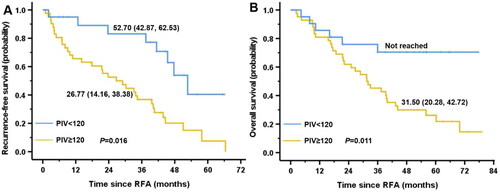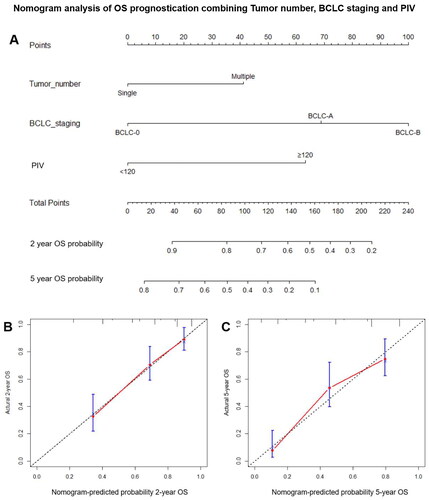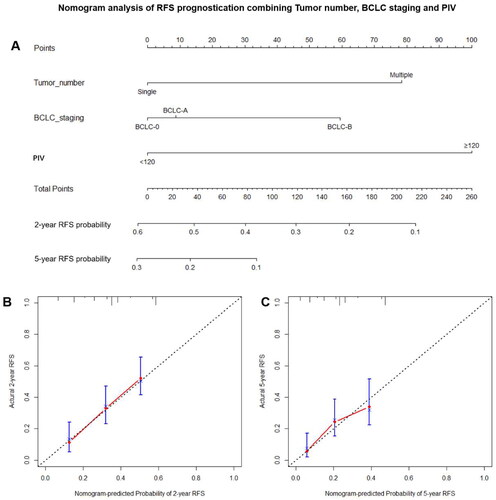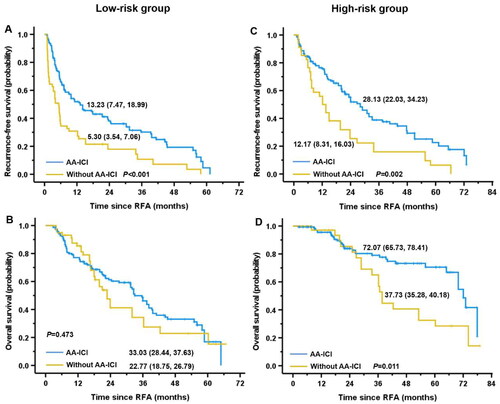Figures & data
Figure 1. High PIV was associated with unfavorable recurrence-free survival (RFS) and overall survival (OS) in early-stage hepatocellular carcinoma treated by curative RFA in testing cohort B after propensity score matching. Kaplan-Meier curves for RFS (A) and OS (B) of patients with high or low PIV. PIV: pan-immune-inflammation value; RFA: radiofrequency ablation.

Figure 2. Prognostic role of PIV was validated in external validating cohort C after propensity score matching. The time-dependent receiver operating characteristic curve (A) of PIV cutoff derived from training cohort A to predict the 5-year overall survival (OS), and Kaplan-Meier curves for OS (B) and recurrence-free survival (C) in early-stage hepatocellular carcinoma treated by curative RFA in external validating cohort C. AUC: area under curve; PIV: pan-immune-inflammation value; RFA: radiofrequency ablation.

Figure 3. The PIV-based nomogram (A) and calibration curves for predicting the 2-year (B) and 5-year (C) OS in external validating cohort C after propensity score matching. PIV: pan-immune-inflammation value; OS: overall survival; BCLC: Barcelona clinic liver cancer.

Figure 4. The PIV-based nomogram (A) and calibration curves for predicting the 2-year (B) and 5-year (C) RFS in external validating cohort C after propensity score matching. PIV: pan-immune-inflammation value; RFS: recurrence-free survival; BCLC: Barcelona clinic liver cancer.

Table 1. Baseline characteristics of patients in the primary and PSM cohorts of external validating cohort C.
Table 2. Univariate and multivariate analysis with the cox proportional hazard model for OS and RFS of early-stage hepatocellular carcinoma treated by radiofrequency ablation in PSM cohort derived from external validating cohort C.
Figure 5. Adjuvant AA-ICI treatment following curative RFA exhibited more benefit in early-stage hepatocellular carcinoma patients in high-risk group in the pooled cohort D. Kaplan-Meier curves for RFS (A) and OS (B) of patients in low-risk group with adjuvant AA-ICI treatment or not. Kaplan-Meier curves for RFS (C) and OS (D) of patients in high-risk group with adjuvant AA-ICI treatment or not. RFA: radiofrequency ablation; RFS: recurrence-free survival; OS: overall survival; AA-ICI: anti-angiogenesis target therapy plus immune checkpoint inhibitor.

Table 3. Baseline characteristics of early-stage hepatocellular carcinoma patients with or without adjuvant AA-ICI treatment following curative RFA between low- and high-risk groups.
Supplemental Material
Download MS Word (2.6 MB)Data availability statement
Data can not be shared publicly because the data from this study contain potentially sensitive private information. Data would be available from the corresponding authors upon reasonable request or on the research data deposit (RDD) platform of Sun Yat-sen University after the manuscript was published.
